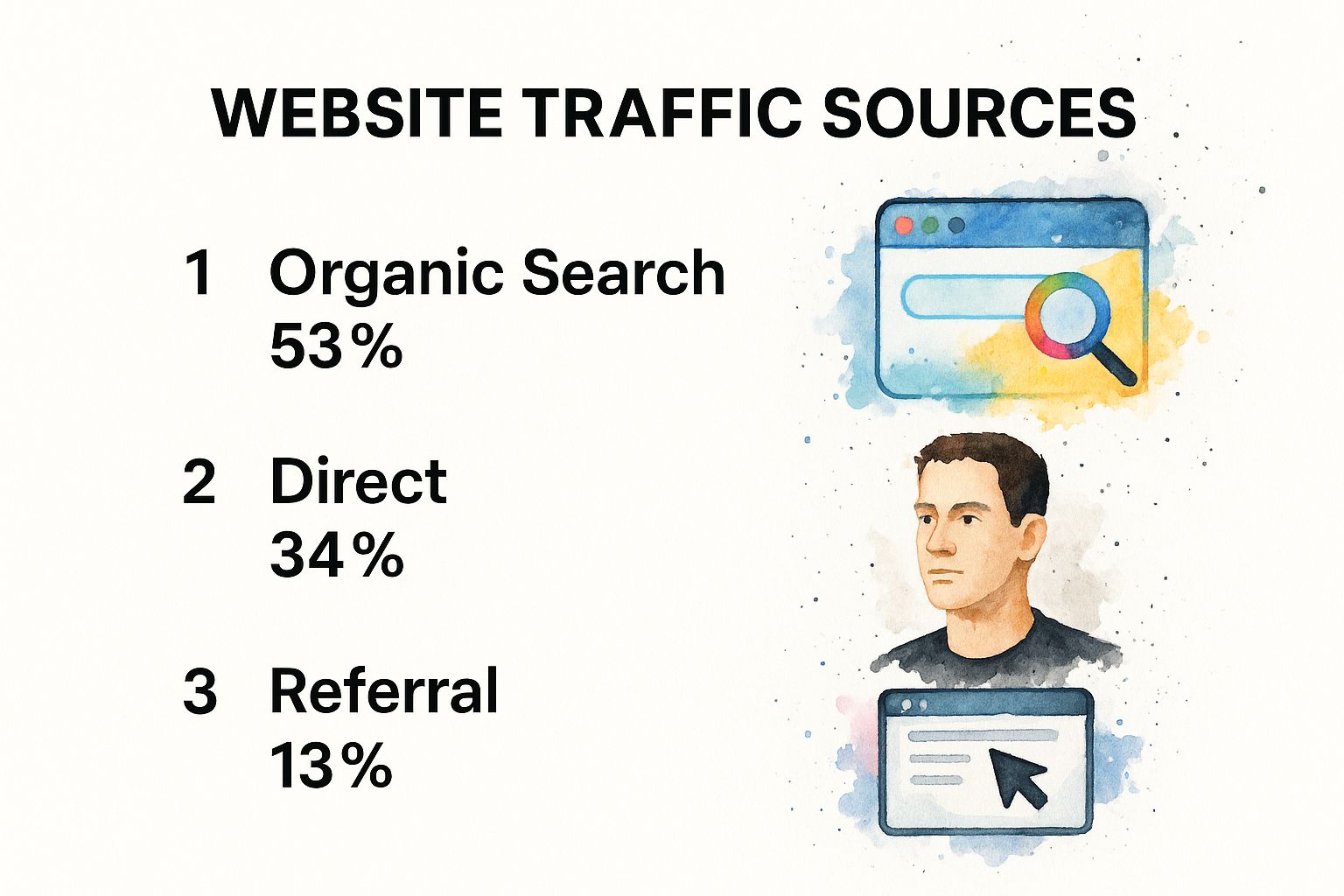If you're looking for a single magic bullet to increase website traffic, I have some bad news: it doesn’t exist. Real, sustainable traffic growth comes from a smart, multi-faceted strategy. It’s about getting several key pieces to work together in harmony.
The good news? It’s not as complicated as it sounds. It really boils down to consistently executing in a few core areas.
Your Blueprint for Sustainable Traffic Growth
Let's cut through the noise. There are countless tactics you could try, but most of them are distractions. To actually move the needle, you need a clear roadmap that focuses on what truly works. This is about building a powerful engine that attracts the right kind of visitors—and keeps them coming back.
Before we dive in, let’s get a clear picture of where website traffic actually comes from. Take a look at this breakdown:

The data is pretty telling. Organic search is the undisputed king, driving over half of all website visitors. This is precisely why a rock-solid SEO foundation is non-negotiable for anyone serious about long-term growth.
The Core Pillars of Traffic Growth
So, where should you focus your energy? Forget about chasing fleeting trends or unreliable shortcuts. Your efforts are best spent on a handful of key areas that deliver compounding returns over time. We'll be breaking down each one in detail throughout this guide, but here’s a high-level look at what we'll cover.
The entire process can be distilled into four foundational pillars. Mastering these is what separates sites that get a trickle of traffic from those that become dominant forces in their niche.
The Four Pillars of Website Traffic Growth
| Strategy Pillar | Primary Focus | Expected Impact |
|---|---|---|
| Search Engine Optimization (SEO) | Understanding search intent and structuring your site and content to rank high in Google. | A consistent, reliable stream of highly relevant visitors actively searching for your solutions. |
| High-Value Content Creation | Producing insightful, engaging content that solves real problems for your target audience. | Attracts visitors, earns valuable backlinks, and establishes your website as a trusted authority. |
| Community & Social Engagement | Building relationships on social media by starting conversations and providing direct value. | Turns casual followers into loyal site visitors and brand advocates. |
| Strategic Link Building | Earning backlinks from reputable websites to signal your authority and credibility to search engines. | Significantly boosts your domain authority, leading to higher rankings and more organic traffic. |
Each of these pillars is a critical component of a healthy traffic strategy. They support and amplify one another. Great content fuels your SEO, social media helps promote that content, and the authority you build from backlinks makes everything more effective.
The biggest mistake I see people make is hitting "publish" and hoping for the best. The most effective approach isn't just writing great content; it's having a promotion plan for every single piece you create. You have to know who your audience is and exactly how you'll reach them before you even start writing.
This blueprint is the foundation of every successful traffic generation campaign I've ever seen or been a part of. In the following sections, we’ll dive deep into each pillar, giving you the actionable steps and practical advice you need to start seeing real results.
Mastering Search Engines for Organic Traffic
Let's be honest: sustainable traffic growth really begins and ends with search engines. Sure, social media can give you some nice traffic spikes, but the reliable, long-term flow of visitors comes from people actively searching for solutions. And for most of the world, that means they’re using Google.
The scale of this channel is just massive. To put it in perspective, Google owned 95.48% of the mobile search market as of December 2023. On desktop, its share hit 87.65% in May 2023. This isn't just dominance; it's a near-monopoly on how people find information online. That’s why getting a handle on Google Search Engine Optimization (SEO) is non-negotiable if you’re serious about growing your website.

But mastering search isn’t about ranking for any keyword. It’s about ranking for the right ones. That’s the difference between attracting window shoppers and pulling in people who are ready to become customers.
Understanding and Targeting Search Intent
The real secret to modern SEO is understanding search intent—the "why" behind every search query. It's no longer enough to just sprinkle keywords on a page. You have to build content that directly solves the user's underlying problem.
For instance, someone searching for "best running shoes" has a completely different goal than someone typing "Nike Pegasus vs. Brooks Ghost." The first person wants a curated list, probably with reviews and categories. The second wants a head-to-head comparison. Your content has to nail that expectation perfectly to rank well and actually help the user.
The breakthrough moment for many marketers is when they stop thinking about keywords and start thinking like their customers. What specific problem are they trying to solve right now? Your content needs to be the most direct, helpful answer they can find.
A practical way to get this right is by mapping your keywords to the different stages of the buyer's journey.
- Informational Intent: People are just looking for information. Think "how to," "what is," or "why." A classic example is "how to start a podcast."
- Navigational Intent: They know where they want to go. A search for "RebelGrowth blog" is a perfect example.
- Commercial Intent: They're in research mode, getting ready to buy. These queries often include words like "best," "review," "comparison," or "top." (e.g., "best email marketing software").
- Transactional Intent: They have their credit card out. Look for terms like "buy," "discount," "price," or "for sale." (e.g., "buy AirPods pro").
If you're looking for the highest ROI, focusing your energy on commercial and transactional keywords is usually the smart move. These are the people closest to making a purchase.
Crafting Title Tags and Meta Descriptions That Get Clicks
Think of your title tag and meta description as your 3-second sales pitch in the search results. You could be ranked #1, but a boring, generic title will get skipped over for something more compelling at #3. Your mission is to create a snippet that’s both informative and absolutely irresistible.
Title Tag Best Practices: * Weave your primary keyword in naturally, ideally near the start. * Keep it under 60 characters so it doesn’t get awkwardly cut off. * Use powerful or emotional words to grab attention—think "Proven," "Ultimate," or "Instantly." * Add numbers or brackets to stand out. "[2024 Guide]" or "11 Actionable Tips" are eye-catching.
Meta Description Best Practices: * This is your ad copy. What's the unique benefit of clicking on your page? * Aim for around 155-160 characters. * Always include a call-to-action. Something as simple as "Learn more," "See the results," or "Get started today" works wonders.
Building Authority with Topic Clusters
A single, amazing blog post is great, but it’s rarely enough to establish your site as a true authority. Google rewards websites that show deep expertise on a subject. The most effective way I've found to do this is by building topic clusters.
Here's how it works. A topic cluster has two main parts: 1. A Pillar Page: This is your big, comprehensive guide on a broad topic, like "The Ultimate Guide to Social Media Marketing." 2. Cluster Content: These are several shorter, more specific articles that dive deep into subtopics, like "How to Create a Facebook Content Calendar" or "Best Times to Post on Instagram." Crucially, all these cluster articles link back to the main pillar page.
This structure does wonders for your SEO. It sends a clear signal to Google that you're an expert in your niche. Plus, the network of internal links spreads authority across your site, lifting the rankings of all the related content. You can see great examples of this strategy in action on the RebelGrowth blog.
To truly get a leg up, it pays to dive into comprehensive SEO resources that explore all facets of optimization. Building your strategy on a solid foundation of proven tactics is the surest path to driving meaningful organic traffic.
If your SEO strategy is the map that guides visitors to your site, then your content is the destination. It’s the entire reason they show up.
But let’s be real. In a world drowning in information, just publishing a blog post and crossing your fingers is a recipe for getting lost in the noise. You need a solid game plan for every single piece of content you push live.
The goal isn't just to write articles; it's to create assets. Think of these as high-value, comprehensive resources that solve genuine problems for your audience. This kind of content builds trust, gets people talking, and ultimately transforms a simple blog into a traffic-driving machine. It's a fundamental shift in thinking—from "What should I write about today?" to "What problem can I solve better than anyone else?"
Go Beyond the Standard Blog Post
Not all content is created equal. Your standard blog post is great for timely updates or quick tips, but if you want to build real authority and pull in that sweet organic traffic, you need to think bigger. It's about diversifying your content portfolio with some heavier hitters.
Consider adding these powerful formats to your mix:
- Pillar Pages: We touched on these earlier, but they're worth repeating. These are massive, exhaustive guides covering a broad topic in incredible detail. A well-executed pillar page can become the go-to resource on a subject, attracting a steady flow of traffic and backlinks for years.
- Data-Rich Case Studies: Nothing builds trust faster than showing your work. A solid case study that walks readers through a real challenge, the exact solution you implemented, and the measurable results is incredibly persuasive.
- Engaging Videos: Video isn't a "nice-to-have" anymore; for many audiences, it's an expectation. Tutorials, product demos, interviews with industry experts—video can grab attention in ways text just can't.
- Interactive Tools: What about a simple calculator, a fun quiz, or a handy generator that gives your visitors instant value? These tools are highly shareable and can be a fantastic, often untapped, source of new traffic.
The right format always comes down to the topic and what your audience actually wants. The key is to deliver the information in the most effective and engaging way possible.
The most common mistake I see is businesses publishing amazing content without a promotion plan. It's like throwing a party but forgetting to send invitations. You need to know exactly who this content is for and how you’re going to get it in front of them before you even write a single word.
The Power of Visuals in Content
Visuals aren't just there to make your content look pretty. They're essential for breaking down complex information and keeping people engaged. Our brains process images an incredible 60,000 times faster than text, which explains why visually rich content almost always performs better.
And you don't need to be a professional graphic designer to make it happen. Tools today have made creating professional-looking visuals almost laughably easy.
Take Canva, for example. You can jump in and quickly create custom graphics for your blog posts, social media, and newsletters with a super gentle learning curve.

Its interface makes it simple for anyone to produce high-quality featured images, charts, and even complex infographics that can seriously boost how long people stick around.
Amplify Your Reach with Strategic Distribution
Creating an incredible piece of content is only half the job. The other half—the one most people neglect—is getting it in front of the right eyeballs. A smart distribution strategy is what ensures all your hard work pays off. This is how you start funneling engaged readers directly to your website.
Here are a few core channels to nail down for distribution:
- Your Email Newsletter: Your email list is your single most valuable asset. These are people who have literally raised their hands and asked to hear from you. Always share your new content with them first—they're your most loyal readers and often the first to share your work.
- Relevant Social Platforms: Don't just blast your link across every social network. Figure out the one or two platforms where your target audience truly hangs out and is most engaged. Then, craft your message specifically for that platform instead of using a lazy, one-size-fits-all post.
- Online Communities and Forums: Where does your audience congregate online? It could be niche subreddits, active Facebook groups, or industry-specific forums. Become a real member, participate genuinely, and only share your content when it’s genuinely helpful and relevant to the conversation.
This multi-channel approach meets people where they already are, helps you build a community, and drives qualified traffic back to your site. This is also where a well-designed content piece can really shine. If your article links out to a conversion-focused page, you can turn that new traffic into actual leads. To learn more about how to design high-converting landing pages and make the most of your promotion, you can dig in further.
By combining killer content with smart distribution, you create a repeatable system for sustainable website growth.
Optimizing Your Site for Technical Performance

You can have the most compelling content in the world, but if your website is slow, broken, or just plain frustrating to use, it’s not going to attract visitors. The technical foundation of your site is a silent but powerful factor in your ability to grow traffic.
A clunky, slow-loading experience is a surefire way to send potential readers clicking the back button before they even see what you have to offer.
On the other hand, a technically sound website is a delight for both users and search engines. It creates a seamless experience that encourages people to stick around, explore your content, and come back for more. This isn't just about appeasing Google; it’s about respecting your visitor's time and providing them with the best possible experience.
Prioritize a Mobile-First Experience
Designing for mobile devices is no longer an optional extra—it's the absolute standard. The shift in user behavior is undeniable.
As of mid-2025, mobile devices account for approximately 64.35% of global website traffic. That’s a staggering increase from just 0.72% in early 2009. This represents an over 8,837% jump in mobile traffic over the last decade and a half.
Ignoring your mobile audience is like closing your doors to two-thirds of your potential visitors.
A mobile-first approach means you design your website for the smallest screen first, then scale up to desktop. This ensures the core functionality and content are flawless for the majority of your users.
Key elements of a great mobile experience include:
- Responsive Design: Your site's layout should automatically adapt to fit any screen size, from a small smartphone to a large desktop monitor.
- Readable Text: Fonts must be large enough to read without pinching and zooming.
- Tap-Friendly Buttons: Links and buttons need enough space between them to be easily tapped with a thumb.
- No Intrusive Pop-ups: Full-screen pop-ups that are tough to close on mobile are a major source of user frustration.
Supercharge Your Page Speed
Website speed is a critical ranking factor for Google and a massive driver of user satisfaction. A few seconds of load time can be the difference between gaining a new reader and losing them forever. If your site feels sluggish, visitors will assume it's low-quality and move on.
A slow website doesn't just annoy visitors; it actively harms your search rankings. Google wants to send its users to sites that provide a fast, efficient experience. Prioritizing speed is one of the highest-impact technical changes you can make to increase website traffic.
Optimizing your site's speed involves a few key actions:
- Compress Your Images: Large, unoptimized images are one of the biggest culprits of slow load times. Use tools to compress images before uploading them without sacrificing too much quality.
- Enable Browser Caching: Caching stores parts of your website on a visitor’s browser, so it doesn’t have to reload everything on their next visit.
- Minimize Code: Clean up unnecessary HTML, CSS, and JavaScript to reduce the amount of data that needs to be loaded.
A slow website can be a major roadblock. If you're struggling with performance issues, it's worth learning how to fix slow WordPress loading to ensure you’re not losing traffic unnecessarily.
Solidify Your Technical SEO Foundation
Beyond speed and mobile-friendliness, a few other technical elements are essential for helping search engines find, understand, and rank your content. Think of these as the behind-the-scenes signals that build trust with Google.
First, make sure your site uses HTTPS. This encrypts the connection between your website and the user's browser, securing their data. Google has confirmed HTTPS is a ranking signal, and most modern browsers will flag non-secure sites, which can scare away visitors.
Next, you need an XML sitemap. This is essentially a roadmap of your website that you submit to search engines. It helps them discover all your important pages and understand your site's structure, ensuring that your valuable content doesn't get overlooked. Getting these fundamentals right creates a solid base for all your other traffic-generating efforts.
7. Build a Real Community on Social Media
Let's get one thing straight: social media isn't just a digital billboard for your latest blog post. Thinking of it that way is a recipe for getting ignored. Instead, picture these platforms as bustling town squares where your ideal audience is already hanging out. Your job isn't to yell at them from a megaphone; it's to walk up, join the conversation, and actually be helpful.
When you just drop links and run, you become noise. The real magic happens when you shift your focus from broadcasting to building. Turn those passive scrollers into a community that genuinely trusts you. That’s how you get consistent referral traffic and a brand loyalty that outlasts any fleeting viral moment.
Choose Your Platforms Wisely
This is a classic rookie mistake. You get excited and try to be on every single social network at once. The result? You spread yourself too thin, burn out, and get mediocre results everywhere.
The smarter move is to be strategic. Figure out where your audience actually lives online and focus your energy there. Be amazing on one or two platforms instead of being forgettable on five.
A B2B software company, for instance, is probably going to get way more traction on LinkedIn, connecting with other professionals. But if you’re selling handcrafted home decor, a visual-first platform like Pinterest or Instagram is your natural habitat. Go deep, not wide.
Create Native Content That Feels Right
Every social platform has its own vibe and unwritten rules. What gets tons of engagement on Twitter (short, punchy text) would be a total flop on Instagram (which is all about high-quality visuals). Forcing the same exact post across every network just feels lazy and out of touch.
You have to adapt your content to feel native to each platform.
- LinkedIn: This is your professional stage. Share industry data, insightful analysis, or career-focused success stories. Keep the tone polished and informative.
- Instagram: It's a visual world. Focus on stunning images, behind-the-scenes Stories, and short, snappy videos (Reels).
- Facebook: This can be the perfect spot to create a dedicated community group. Mix up your content with questions, polls, and conversation starters to get people talking.
Your content should blend seamlessly into a user's feed, feeling like a natural part of their experience, not a jarring ad.
The most powerful shift you can make is to stop asking, "How can I get traffic from this platform?" and start asking, "How can I provide value to the people on this platform?" When you lead with genuine helpfulness, the traffic will follow.
Spark Conversations, Not Just Clicks
The real power of social media is that it's a two-way street. Just posting a link and hoping for the best is a huge missed opportunity. The name of the game is interaction.
Your primary goal should be to get people talking. Ask open-ended questions. Invite your followers to share their own opinions or experiences. And when someone takes the time to comment, give them a thoughtful reply—not just a generic "Thanks!" It shows you're actually listening.
One of the most effective ways to do this is by creating a dedicated Facebook Group for your niche. This gives like-minded people a place to connect, ask questions, and feel like they’re part of something exclusive. For many blogs, this has been a total game-changer, building a loyal tribe that drives consistent traffic and engagement back to their site. You become the hub of your community.
Are You Ready for What's Next in Website Traffic?
The digital marketing world never sits still. What worked to drive traffic last year might be obsolete next year. To stay ahead, you can't just follow current best practices; you need a strategy that's built to last, one that can handle whatever comes next.
Right now, the biggest shift on the horizon is the full integration of AI into search. And this isn't some far-off, futuristic idea. It's happening now, and preparing for it is the only way to secure your traffic for the long haul.
But don't panic. The fundamentals still work. A 2024 report showed that despite all the algorithm chaos, 43% of web analysts still saw their traffic grow year-over-year, while only 14% saw a drop. As tools like Google's Gemini become the norm, the game will tilt even more toward exceptional, multi-format content. You can dig into the full details of these traffic analytics findings on HubSpot's blog.
Adapting to an AI-Powered Search World
So, what does it mean to be "AI-ready"? It means creating content that AI models and search engines can instantly recognize as genuinely helpful and authoritative. This is about moving beyond just words on a page. Think bigger: a rich blend of text, original images, and video that gives people comprehensive answers.
This is where the concept of E-E-A-T (Experience, Expertise, Authoritativeness, and Trustworthiness) becomes absolutely critical. Search engines are getting frighteningly good at figuring out who's faking it and who's demonstrating real, firsthand experience.
Instead of just explaining what something is, future-proof content needs to show how it works. We're talking original visuals, personal stories, and unique data. This is how you build real trust—with both your audience and the algorithms that serve them.
Actionable Steps for a Resilient Strategy
To get your site ready, you need to start thinking about your content differently. Ask yourself: how can I add more undeniable value and prove my expertise?
- Optimize for How People Actually Talk: Forget stilted keywords. People are asking their devices long, conversational questions. Your content needs to answer them directly, using clear H2s and H3s that mirror those natural queries.
- Go Beyond Text: Don't just publish another blog post. Embed a quick tutorial video. Create an original infographic that simplifies a complex idea. Add high-quality, non-stock photos. This creates a far more engaging and valuable experience.
- Put Your Expertise on Display: Feature author bios that scream credibility and experience. Publish case studies with cold, hard numbers. Anything that proves you're a legitimate authority will give you a massive edge. For a masterclass in this, check out the brands and experts in our RebelGrowth directory to see how the pros establish their credibility.
Got Questions About Website Traffic? We've Got Answers
Even with the best guide in hand, you’re bound to have questions pop up along the way. That's totally normal. Let's tackle a few of the most common ones I hear from people trying to grow their traffic.
How Long Does SEO Take to Show Results?
This is the million-dollar question, and the honest-to-goodness answer is: it depends. I know, not what you wanted to hear. But it's the truth.
As a general rule of thumb, you can expect to see some initial movement in your search rankings within 3 to 6 months of consistent, focused effort. But for really competitive keywords—the ones everyone wants—it can easily take closer to a year to lock in those top spots that drive serious traffic.
A few things can speed up or slow down that timeline:
- Website Age and Authority: If your site is brand new, Google needs time to learn to trust it. Older, more established sites have a head start.
- The Competition: Trying to rank for "local bakery in a small town" is a whole different ballgame than going after "best credit cards." The tougher the competition, the longer the wait.
- Your Content Game: If you’re regularly publishing genuinely helpful, well-optimized content, you're sending all the right signals to Google and will see results faster.
The most important thing to remember is that SEO is a marathon, not a sprint. The results you build are cumulative. Think of it like a snowball rolling downhill—it starts small, but over time it becomes a massive, unstoppable force of sustainable traffic for your business.
How Can I Get Traffic with a Small Budget?
Don't let a tight budget fool you into thinking you can't drive traffic. You absolutely can. When you're low on cash, your most valuable assets become your time and your creativity. You just have to be smart about where you invest them.
Forget expensive tools and ads for now. Go all-in on foundational SEO. I'm talking about meticulous keyword research and flawless on-page optimization—these cost nothing but your effort.
From there, focus on creating one or two pieces of content that are insanely helpful. The kind of content that solves a very specific problem for your audience better than anything else out there. Then, take that content and become an active, valuable member of the online communities where your people hang out. Think relevant subreddits, niche Facebook groups, or industry forums. Don't just show up and drop links; answer questions, offer advice, and build real relationships. Value first, traffic second.
What Analytics Should I Actually Be Tracking?
It's so easy to get completely lost in a sea of data. My advice? Keep it simple, especially at the beginning. Focus on a handful of key metrics that tell you what’s really moving the needle.
- Traffic Sources: Where are your visitors coming from? Organic search? Social media? Direct visits? This tells you which channels are your winners so you can double down on what's working.
- Top Pages: Which of your articles or landing pages are attracting the most eyeballs? This is your audience telling you exactly what kind of content they love. Make more of it.
- Bounce Rate: What percentage of people land on a page and then leave without clicking anywhere else? A consistently high bounce rate can be a red flag that your content isn't matching what people expected to find.
Ready to stop guessing and start growing? RebelGrowth provides the AI-powered tools you need to create optimized content, build backlinks, and automate your social media marketing. See how you can increase your website traffic by visiting https://rebelgrowth.com.
